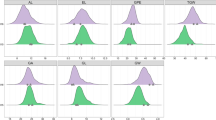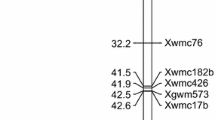Abstract
Changes in alleles frequencies of marker loci linked to yield quantitative trait loci (QTL) were studied in 188 barley entries (landraces, old and modern cultivars) grown in six trials representing low and high yielding conditions in Spain (2004) and Syria (2004, 2005). A genome wise association analysis was performed per trial, using 811 DArT® markers of known map position. At the first stage of analysis, spatially adjusted genotypic means were created per trial by fitting mixed models. At the second stage, single QTL models were fitted with correction for population substructure, using regression models. Finally, multiple QTL models were constructed by backward selection from a regression model containing all significant markers from the single QTL analyses. In addition to the association analyses per trial, genotype by environment interaction was investigated across the six trials. Landraces seemed best adapted to low yielding environments, while old and modern entries adapted better to high yielding environments. The number of QTL and the magnitude of their effects were comparable for low and high input conditions. However, none of the QTL were found within a given bin at any chromosome in more than two of the six trials. Changes in allele frequencies of marker loci close to QTL for grain yield in landraces, old and modern barley cultivars could be attributed to selection exercised in breeding, suggesting that modern breeding may have increased frequencies of marker alleles close to QTL that favour production particularly under high yield potential environments. Moreover, these results also indicate that there may be scope for improving yield under low input systems, as breeding so far has hardly changed allele frequencies at marker loci close to QTL for low yielding conditions.

Similar content being viewed by others
References
Austin DF, Lee M (1998) Detection of quantitative trait loci for grain yield and yield components in maize across generations in stress and non stress environments. Crop Sci 38:1296–1308
Baum M, Grando S, Backes G, Jahoor A, Sabbagh A, Ceccarelli S (2003) QTL for agronomic traits in the Mediterranean environment identified in recombinant inbred lines of the cross ‘Arta’ × H. spontaneum 41-1. Theor Appl Genet 107:1215–1225
Beavis WD, Keim P (1996) Identification of QTL that are affected by the environment. In: Kang MS, Hugh HG (eds) New perspective on genotype-by-environment interactions. CRC Press, Inc, Boca Raton, FL
Bedo Z, Láng L, Veisz O, Gy Vida (2005) Breeding of winter wheat (Triticum aestivum L.) for different adaptation types in multilocational agricultural production. Turk J Agric For 29:151–156
Benjamini Y, Hochberg Y (1995) Controlling the false discovery rate: a practical and powerful approach to multiple testing. J R Stat Soc B 57:289–300
Benjamini Y, Yekutieli D (2005) Quantitative trait loci analysis using the false discovery rate. Genetics 171:783–790
Boer MP, Wright D, Feng L, Podlich DW, Luo L, Cooper M, van Eeuwijk FA (2007) A mixed-model quantitative trait loci (QTL) analysis for multiple-environment trial data using environmental covariables for QTL-by-environment interactions, with an example in Maize. Genetics 177:1801–1813
Ceccarelli S (1996a) Positive interpretation of genotype by environment interactions in relation to sustainability and biodiversity. In: Cooper M, Hammer GL (eds) Plant adaptation and crop improvement. CABI Publishing, Wallingford, UK, pp 467–486
Ceccarelli S (1996b) Adaptation to low and high input cultivation. Euphytica 92:203–214
Ceccarelli S, Grando S (1993) From conventional plant breeding to molecular biology. International Crop Science I, Crop Science Society of America, Inc. Madison, WI 53711, USA, pp 533–538
Comadran J, Russell JR, van Eeuwijk FA, Ceccarelli S, Grando S, Baum M, Stanca AM, Pecchioni N, Mastrangelo AM, Akar T, Al-Yassin A, Benbelkacem A, Choumane W, Ouabbou H, Dahan R, Bort J, Araus J-L, Pswarayi A, Romagosa I, Hackett CA, Thomas WTB (2008a) Mapping adaptation of barley to droughted environments. Euphytica 161:35–45
Comadran J, Russell JR, Thomas WTB, van Eeuwijk FA, Ceccarelli S, Grando S, Baum M, Stanca AM, Pecchioni N, Akar T, Al-Yassin A, Benbelkacem A, Choumane W, Ouabbou H, Bort J, Hackett CA, Romagosa I (2008b) Patterns of structure and LD in Mediterranean barley for adaptation to drought. 10th International Barley Genetics Symposium. Bibliotheca Alexandrina, Alexandria, Egypt, 5th–10th April 2008 (in press)
Daberkow SG, Reichelderfer KH (1988) Low-input agriculture: trends, goals and prospects for input use. Am J Agric Econ 70:1159–1166
Falconer DS (1981) The problem of environment and selection. Am Nat 86:293–298
Forster BP, Ellis RP, Thomas WTB, Newton AC, Tuberosa R, This D, El-Enein RA, Bahri MH, Ben Salem M (2000) The development and application of molecular markers for abiotic stress tolerance in barley. J Exp Bot 51:19–27
Forster BP, Ellis RP, Moir J, Talame V, Sanguineti MC, Tuberosa R, This D, Teulat-Merah B, Ahmed I, Mariy SAEE, Bahri H, el Ouahabi M, Zoumarou-Wallis N, el-Fellah M, Ben Salem M (2004) Genotype and phenotype associations with drought tolerance in barley tested in North Africa. Ann Appl Biol 144:157–168
Francia E, Rizza F, Cattiveli L, Stanca AM, Galiba G, Tóth B, Hayes PM, Skinner JS, Pecchioni N (2004) Two loci on chromosome 5H determine low-temperature tolerance in a “Nure” × “Tremois” (spring) barley map. Theor Appl Genet 108:670–680
Gauch HG (1992) Statistical analysis of regional yield trials: AMMI analysis of factorial designs. Elsevier, Amsterdam, The Netherlands
Hemamalilni GS, Shahidhar HE, Hittalmani S (2000) Molecular marker assisted tagging of morphological and physiological traits under two contrasting moisture regimes at peak vegetative stage in rice (Oryza sativa L.). Euphytica 112:69–78
Laperche A, Brancourt-Hulmel M, Heumez E, Gardet O, Le Gouis J (2006) Estimation of gentic paprameters of a DH wheat population grown at different stress levels characterised by probe genotypes. Theor Appl Genet 112:797–807
Lin CY, Togashi K (2002) Genetic improvement in the presence of genotype by environment interaction. Anim Sci J 73:3–11
Malosetti M, Voltas J, Romagosa I, Ullrich SE, van Eeuwijk FA (2004) Mixed models including environmental covariables for studying QTL by environment interaction. Euphytica 137:139–145
Murphy KM, Campbell KG, Lyon SR, Jones SS (2007) Evidence of varietal adaptation to organic farming systems. Field Crops Res 102:172–177
Payne RW, Harding SA, Murray DA, Soutar DM, Baird DB, Welham SJ, Kane AF, Gilmour AR, Thompson R, Webster R, Tunnicliffe E, Wilson G (2006) GenStat release 9 reference manual, part 2 directives. VSN International, Hemel Hempstead, UK
Piepho HP, Williams ER, Fleck M (2005) A note on the analysis of designed experiments with complex treatment structure. HortScience 41(2):446–452
Pritchard JK, Stephens M, Donnelly P (2000) Inference of population structure using multilocus genotype data. Genetics 155:945–959
Pswarayi A, van Eeuwijk FA, Ceccarelli S, Grando S, Comadran J, Russell JR, Francia E, Pecchioni N, Li Destri O, Akar T, Al-Yassin A, Benbelkacem A, Choumane W, Karrou M, Ouabbou H, Bort J, Araus JL, Molina-Cano JL, Thomas, WTB, Romagosa I (2008) Barley adaptation and improvement in the Mediterranean basin. Plant Breed (in press)
Romagosa I, Ullrich SE, Han F, Hayes PM (1996) Use of the AMMI model in QTL mapping for adaptation in barley. Theor Appl Genet 93:30–37
Rosielle AA, Hamblin J (1981) Theoretical aspects of selection for yield in stress and non-stress environments. Crop Sci 21:943–946
Russell J, Booth A, Fuller J, Harrower B, Hedley P, Machray G, Powell E (2004) A comparison of sequence-based polymorphism and haplotype content in transcribed and anonymous regions of the barley genome. Genome 47:389–398
Teulat B, Merah O, Sirault X, Borries C, Waugh R, This D (2002) QTL for grain carbon isotope discrimination in field grown barley. Theor Appl Genet 106:118–126
Teulat B, Zoumarou-Wallis N, Rotter B, Ben Salem M, Bahri H, This D (2003) QTL for Relative water content in field-grown barley and their stability across Mediterranean environments. Theor Appl Genet 108:181–188
Tondelli A, Francia E, Barabaschi D, Aprile A, Skinner JS, Stockinger EJ, Stanca AM, Pecchioni N (2006) Mapping regulatory genes as candidates for cold and drought stress tolerance in barley. Theor Appl Genet 112:445–454
Wenzl P, Carling J, Kudrna D, Jaccoud D, Huttner E, Kleinhofs A, Kilian A (2004) Diversity arrays technology (DArT) for whole-genome profiling of barley. Proc Natl Acad Sci USA 101:9915–9920
Wenzl P, Li H, Carling J, Zhou M, Raman H, Paul E, Hearnden P, Maier C, Xia L, Caig V, Ovesná J, Fakir M, Poulsen D, Wang J, Raman R, Smith KP, Muehlbauer GJ, Chalmers KJ, Kleinhofs A, Huttner E, Kilian A (2006) A high-density consensus map of barley linking DArT markers to SSR, RFLP and STS loci and agricultural traits. BMC Genom 7:206. doi:10.1186/1471-2164-7-206
Acknowledgments
The above work was funded by the European Union-INCO-MED program (ICA3-CT2002-10026) Mapping Adaptation of Barley to Drought Environments (MABDE). The Centre UdL-IRTA forms part of the Centre CONSOLIDER on Agrigenomics funded by the Spanish Ministry of Education and Science and acknowledges partial funding from grant AGL2005-07195-C02-02. Fred van Eeuwijk wants to acknowledge funding of the Generation Challenge Program (project G4007.09: Methodology and software development for marker-trait association analyses). We also want to express our gratitude to two anonymous reviewers whose suggestions improved this article.
Author information
Authors and Affiliations
Corresponding author
Rights and permissions
About this article
Cite this article
Pswarayi, A., van Eeuwijk, F.A., Ceccarelli, S. et al. Changes in allele frequencies in landraces, old and modern barley cultivars of marker loci close to QTL for grain yield under high and low input conditions. Euphytica 163, 435–447 (2008). https://doi.org/10.1007/s10681-008-9726-1
Received:
Accepted:
Published:
Issue Date:
DOI: https://doi.org/10.1007/s10681-008-9726-1




